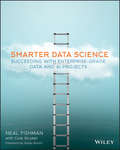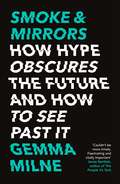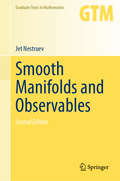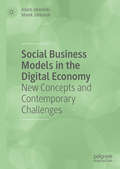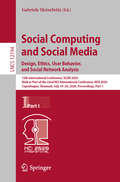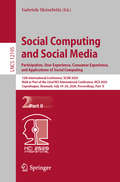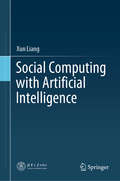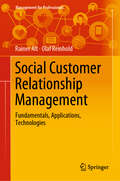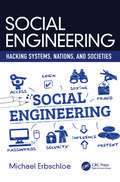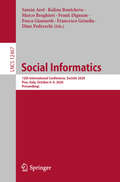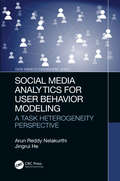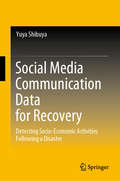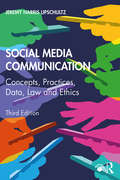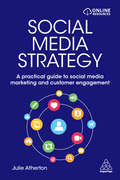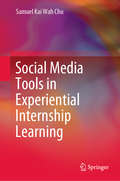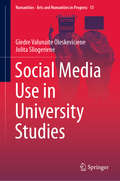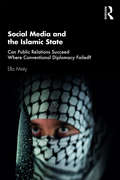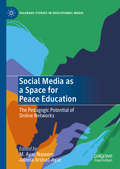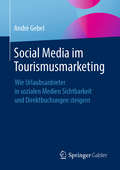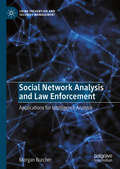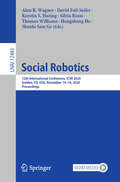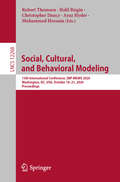- Table View
- List View
Smarter Data Science: Succeeding with Enterprise-Grade Data and AI Projects
by Cole Stryker Neal FishmanOrganizations can make data science a repeatable, predictable tool, which business professionals use to get more value from their data Enterprise data and AI projects are often scattershot, underbaked, siloed, and not adaptable to predictable business changes. As a result, the vast majority fail. These expensive quagmires can be avoided, and this book explains precisely how. Data science is emerging as a hands-on tool for not just data scientists, but business professionals as well. Managers, directors, IT leaders, and analysts must expand their use of data science capabilities for the organization to stay competitive. Smarter Data Science helps them achieve their enterprise-grade data projects and AI goals. It serves as a guide to building a robust and comprehensive information architecture program that enables sustainable and scalable AI deployments. When an organization manages its data effectively, its data science program becomes a fully scalable function that’s both prescriptive and repeatable. With an understanding of data science principles, practitioners are also empowered to lead their organizations in establishing and deploying viable AI. They employ the tools of machine learning, deep learning, and AI to extract greater value from data for the benefit of the enterprise. By following a ladder framework that promotes prescriptive capabilities, organizations can make data science accessible to a range of team members, democratizing data science throughout the organization. Companies that collect, organize, and analyze data can move forward to additional data science achievements: Improving time-to-value with infused AI models for common use cases Optimizing knowledge work and business processes Utilizing AI-based business intelligence and data visualization Establishing a data topology to support general or highly specialized needs Successfully completing AI projects in a predictable manner Coordinating the use of AI from any compute node. From inner edges to outer edges: cloud, fog, and mist computing When they climb the ladder presented in this book, businesspeople and data scientists alike will be able to improve and foster repeatable capabilities. They will have the knowledge to maximize their AI and data assets for the benefit of their organizations.
Smiley. Herzchen. Hashtag.: Zwischenmenschliche Kommunikation im Zeitalter von Facebook, WhatsApp, Instagram @ Co. (Über/Strom: Wegweiser durchs digitale Zeitalter)
by Uta ButtkewitzLieber eine schnelle Sprachnachricht als ein persönlicher Anruf, ein Smiley statt eines Grußes – die Kommunikation verändert sich im digitalen Zeitalter. Kommunikation wird unverbindlich, aber gleichzeitig steigt der Kommunikationsdruck durch soziale Medien und Netzwerke. Wir stehen unter Druck, jederzeit schnell zu kommunizieren. In Ruhe einen Kaffee trinken, die Aussicht genießen? Geht nicht, jede WhatsApp muss umgehend beantwortet werden und die Likes unter dem Foto zählen mehr als der Genuss des Augenblicks. Viel zu kurz kommt bei all dem die zwischenmenschliche Kommunikation.Dieses Buch zeigt, wie aktuelle Kommunikationsmedien wie WhatsApp, Facebook oder Instagram die zwischenmenschliche Kommunikation beeinflussen und wie diese Veränderungen unsere Beziehungen und unser gesellschaftliches Zusammenleben schleichend verändern. Die Verfügbarkeit einer Vielzahl von Medien stellt uns vor große Herausforderungen. Wenn Sie sich schon immer gefragt haben, warum das Kommunizieren im Privat- oder Berufsleben plötzlich schwieriger geworden ist, finden Sie in diesem Buch Antworten darauf. Sie lernen, wie Sie im digitalen Zeitalter bei sich bleiben und sich nicht von kurzfristigen Erregungszuständen der Medien aus dem Gleichgewicht bringen lassen. Treffen Sie bewusste Entscheidungen für Medien und ihre Nutzung und erobern Sie Ihre kommunikative Selbstbestimmung zurück!
Smoke & Mirrors: How Hype Obscures the Future and How to See Past It
by Gemma Milne'Stop following the news until you've read Gemma Milne's persuasive analysis of the hype and bullshit that distort our understanding of emerging science. As she shows, the starting point to grasping the genuine opportunities of AI, life sciences and climate tech is a healthy dose of critical thinking'David Rowan, founding editor of WIRED UK and author of Non-Bullshit Innovation: Radical Ideas from the World's Smartest Minds'Couldn't be more timely. Fascinating and vitally important'Jamie Bartlett, author of The People Vs Tech'A much-needed blast of fresh air! Gemma Milne expertly shows us how to separate the truth from the hype surrounding the emerging techs of today, and those of the near-tomorrow'Lewis Dartnell, author of Origins: How the Earth Made Us'I loved this book! This is exactly the sort of sceptical, cut-through-the crap-but-still-excited-about-what's-emerging book around tech innovation that's sorely needed, yet is so hard to find . . . essential reading for anyone who's serious about how real-world advances might be effectively harnessed to build a better future'Dr Andrew Maynard, scientist and author of Films from the Future and Future Rising'[A] vital contribution in a world where technological progress promises so much, but too often disappoints. If, like me, you believe that advances in science and technology are our best hope for solving the grand challenges of our times, this book is the indispensable guide to avoiding the mirages and the charlatans along the way'Matt Clifford, co-founder and CEO of Entrepreneur First'A refreshingly grown-up, clear-headed look at the interaction between science, technology and the media - readable without being dumbed down, acknowledging complexities without being heavy'Tom Chivers, author of The AI Does Not Hate You'ROBOTS WILL STEAL YOUR JOB!''AI WILL REVOLUTIONISE FARMING!''GENETIC EDITING WILL CURE CANCER!'Bombastic headlines about science and technology are nothing new. To cut through the constant stream of information and misinformation on social media, or grab the attention of investors, or convince governments to take notice, strident headlines or bold claims seem necessary to give complex, nuanced information some wow factor.But hype has a dark side, too.It can mislead. It can distract. It can blinker us from seeing what is actually going on.From AI, quantum computing and brain implants, to cancer drugs, future foods and fusion energy, science and technology journalist Gemma Milne reveals hype to be responsible for fundamentally misdirecting or even derailing crucial progress.Hype can be combated and discounted, though, if you're able to see exactly where, how and why it is being deployed.This book is your guide to doing just that.
Smoke & Mirrors: How Hype Obscures the Future and How to See Past It
by Gemma Milne'Stop following the news until you've read Gemma Milne's persuasive analysis of the hype and bullshit that distort our understanding of emerging science. As she shows, the starting point to grasping the genuine opportunities of AI, life sciences and climate tech is a healthy dose of critical thinking'David Rowan, founding editor of WIRED UK and author of Non-Bullshit Innovation: Radical Ideas from the World's Smartest Minds'Couldn't be more timely. Fascinating and vitally important'Jamie Bartlett, author of The People Vs Tech'A much-needed blast of fresh air! Gemma Milne expertly shows us how to separate the truth from the hype surrounding the emerging techs of today, and those of the near-tomorrow'Lewis Dartnell, author of Origins: How the Earth Made Us'I loved this book! This is exactly the sort of sceptical, cut-through-the crap-but-still-excited-about-what's-emerging book around tech innovation that's sorely needed, yet is so hard to find . . . essential reading for anyone who's serious about how real-world advances might be effectively harnessed to build a better future'Dr Andrew Maynard, scientist and author of Films from the Future and Future Rising'[A] vital contribution in a world where technological progress promises so much, but too often disappoints. If, like me, you believe that advances in science and technology are our best hope for solving the grand challenges of our times, this book is the indispensable guide to avoiding the mirages and the charlatans along the way'Matt Clifford, co-founder and CEO of Entrepreneur First'A refreshingly grown-up, clear-headed look at the interaction between science, technology and the media - readable without being dumbed down, acknowledging complexities without being heavy'Tom Chivers, author of The AI Does Not Hate You'ROBOTS WILL STEAL YOUR JOB!''AI WILL REVOLUTIONISE FARMING!''GENETIC EDITING WILL CURE CANCER!'Bombastic headlines about science and technology are nothing new. To cut through the constant stream of information and misinformation on social media, or grab the attention of investors, or convince governments to take notice, strident headlines or bold claims seem necessary to give complex, nuanced information some wow factor.But hype has a dark side, too.It can mislead. It can distract. It can blinker us from seeing what is actually going on.From AI, quantum computing and brain implants, to cancer drugs, future foods and fusion energy, science and technology journalist Gemma Milne reveals hype to be responsible for fundamentally misdirecting or even derailing crucial progress.Hype can be combated and discounted, though, if you're able to see exactly where, how and why it is being deployed.This book is your guide to doing just that.
Smoke & Mirrors: How Hype Obscures the Future and How to See Past It
by Gemma Milne'Stop following the news until you've read Gemma Milne's persuasive analysis of the hype and bullshit that distort our understanding of emerging science. As she shows, the starting point to grasping the genuine opportunities of AI, life sciences and climate tech is a healthy dose of critical thinking'David Rowan, founding editor of WIRED UK and author of Non-Bullshit Innovation: Radical Ideas from the World's Smartest Minds'Couldn't be more timely. Fascinating and vitally important'Jamie Bartlett, author of The People Vs Tech'A much-needed blast of fresh air! Gemma Milne expertly shows us how to separate the truth from the hype surrounding the emerging techs of today, and those of the near-tomorrow'Lewis Dartnell, author of Origins: How the Earth Made Us'I loved this book! This is exactly the sort of sceptical, cut-through-the crap-but-still-excited-about-what's-emerging book around tech innovation that's sorely needed, yet is so hard to find . . . essential reading for anyone who's serious about how real-world advances might be effectively harnessed to build a better future'Dr Andrew Maynard, scientist and author of Films from the Future and Future Rising'[A] vital contribution in a world where technological progress promises so much, but too often disappoints. If, like me, you believe that advances in science and technology are our best hope for solving the grand challenges of our times, this book is the indispensable guide to avoiding the mirages and the charlatans along the way'Matt Clifford, co-founder and CEO of Entrepreneur First'A refreshingly grown-up, clear-headed look at the interaction between science, technology and the media - readable without being dumbed down, acknowledging complexities without being heavy'Tom Chivers, author of The AI Does Not Hate You'ROBOTS WILL STEAL YOUR JOB!''AI WILL REVOLUTIONISE FARMING!''GENETIC EDITING WILL CURE CANCER!'Bombastic headlines about science and technology are nothing new. To cut through the constant stream of information and misinformation on social media, or grab the attention of investors, or convince governments to take notice, strident headlines or bold claims seem necessary to give complex, nuanced information some wow factor.But hype has a dark side, too.It can mislead. It can distract. It can blinker us from seeing what is actually going on.From AI, quantum computing and brain implants, to cancer drugs, future foods and fusion energy, science and technology journalist Gemma Milne reveals hype to be responsible for fundamentally misdirecting or even derailing crucial progress.Hype can be combated and discounted, though, if you're able to see exactly where, how and why it is being deployed.This book is your guide to doing just that.
Smooth Manifolds and Observables (Graduate Texts in Mathematics #220)
by Jet NestruevThis book gives an introduction to fiber spaces and differential operators on smooth manifolds. Over the last 20 years, the authors developed an algebraic approach to the subject and they explain in this book why differential calculus on manifolds can be considered as an aspect of commutative algebra. This new approach is based on the fundamental notion of observable which is used by physicists and will further the understanding of the mathematics underlying quantum field theory.
Social Business Models in the Digital Economy: New Concepts and Contemporary Challenges
by Adam Jabłoński Marek JabłońskiFilling a gap in the current literature, this book addresses the social approach to the design and use of innovative business models in the digital economy. It focuses on three areas that are of increasing importance to businesses and industry today: social issues and sustainability; digitization; and new economic business models, specifically the sharing and circular economies. The authors aim to solve current scientific concerns around the conceptualization and operationalization of social business models, addressing management intentions and the impact of these models on society. Based on observation of social phenomena and the authors' research and practical experience, the book highlights best practices for designing and assessing social business models.
Social Computing and Social Media. Design, Ethics, User Behavior, and Social Network Analysis: 12th International Conference, SCSM 2020, Held as Part of the 22nd HCI International Conference, HCII 2020, Copenhagen, Denmark, July 19–24, 2020, Proceedings, Part I (Lecture Notes in Computer Science #12194)
by Gabriele MeiselwitzThis two-volume set LNCS 12194 and 12195 constitutes the refereed proceedings of the 12th International Conference on Social Computing and Social Media, SCSM 2020, held as part of the 22nd International Conference, HCI International 2020, which was planned to be held in Copenhagen, Denmark, in July 2020. The conference was held virtually due to the COVID-19 pandemic. The total of 1439 papers and 238 posters have been accepted for publication in the HCII 2020 proceedings from a total of 6326 submissions. SCSM 2020 includes a total of 93 papers which are organized in topical sections named: Design Issues in Social Computing, Ethics and Misinformation in Social Media, User Behavior and Social Network Analysis, Participation and Collaboration in Online Communities, Social Computing and User Experience, Social Media Marketing and Consumer Experience, Social Computing for Well-Being, Learning, and Entertainment.
Social Computing and Social Media. Participation, User Experience, Consumer Experience, and Applications of Social Computing: 12th International Conference, SCSM 2020, Held as Part of the 22nd HCI International Conference, HCII 2020, Copenhagen, Denmark, July 19–24, 2020, Proceedings, Part II (Lecture Notes in Computer Science #12195)
by Gabriele MeiselwitzThis two-volume set LNCS 12194 and 12195 constitutes the refereed proceedings of the 12th International Conference on Social Computing and Social Media, SCSM 2020, held as part of the 22nd International Conference, HCI International 2020, which was planned to be held in Copenhagen, Denmark, in July 2020. The conference was held virtually due to the COVID-19 pandemic. The total of 1439 papers and 238 posters have been accepted for publication in the HCII 2020 proceedings from a total of 6326 submissions. SCSM 2020 includes a total of 93 papers which are organized in topical sections named: Design Issues in Social Computing, Ethics and Misinformation in Social Media, User Behavior and Social Network Analysis, Participation and Collaboration in Online Communities, Social Computing and User Experience, Social Media Marketing and Consumer Experience, Social Computing for Well-Being, Learning, and Entertainment.
Social Computing with Artificial Intelligence
by Xun LiangThis book provides a comprehensive introduction to the application of artificial intelligence in social computing, from fundamental data processing to advanced social network computing. To broaden readers’ understanding of the topics addressed, it includes extensive data and a large number of charts and references, covering theories, techniques and applications. It particularly focuses on data collection, data mining, artificial intelligence algorithms in social computing, and several key applications of social computing application, and also discusses network propagation mechanisms and dynamic analysis, which provide useful insights into how information is disseminated in online social networks. This book is intended for readers with a basic knowledge of advanced mathematics and computer science.
Social Customer Relationship Management: Fundamentals, Applications, Technologies (Management for Professionals)
by Rainer Alt Olaf ReinholdSocial media has received considerable attention, and many potential benefits, as well as concerns, are now being discussed. This book explores how social media can successfully support business processes in marketing, sales and service in the context of customer relationship management (CRM). It presents the fundamentals of Social CRM and shows how small and large companies alike have implemented it.In turn, the book presents analytic and operational software tools that offer features for enhancing and streamlining interactions with customers. The book concludes with an overview of essential design areas that businesses need to bear in mind when introducing social media into their CRM strategies. In this regard, it also points out key success factors, limitations, and data protection aspects.
Social Engineering: Hacking Systems, Nations, and Societies
by Michael ErbschloeThis book analyzes of the use of social engineering as a tool to hack random systems and target specific systems in several dimensions of society. It shows how social engineering techniques are employed well beyond what hackers do to penetrate computer systems. And it explains how organizations and individuals can socially engineer their culture to help minimize the impact of the activities of those who lie, cheat, deceive, and defraud. After reading this book, you’ll be able to analyze how organizations work and the need for security to maintain operations and sustainability, and be able to identify, respond to and counter socially engineered threats to security.
Social Informatics: 12th International Conference, SocInfo 2020, Pisa, Italy, October 6–9, 2020, Proceedings (Lecture Notes in Computer Science #12467)
by Dino Pedreschi Frank Dignum Kalina Bontcheva Samin Aref Marco Braghieri Fosca Giannotti Francesco GrisoliaThis volume constitutes the proceedings of the 12th International Conference on Social Informatics, SocInfo 2020, held in Pisa, Italy, in October 2020. The 30 full and 3 short papers presented in these proceedings were carefully reviewed and selected from 99 submissions. The papers presented in this volume cover a broad range of topics, ranging from works that ground information-system design on social concepts, to papers that analyze complex social systems using computational methods, or explore socio-technical systems using social sciences methods.
Social Media Analytics for User Behavior Modeling: A Task Heterogeneity Perspective (Data-Enabled Engineering)
by Arun Reddy Nelakurthi Jingrui HeWinner of the "Outstanding Academic Title" recognition by Choice for the 2020 OAT Awards. The Choice OAT Award represents the highest caliber of scholarly titles that have been reviewed by Choice and conveys the extraordinary recognition of the academic community. In recent years social media has gained significant popularity and has become an essential medium of communication. Such user-generated content provides an excellent scenario for applying the metaphor of mining any information. Transfer learning is a research problem in machine learning that focuses on leveraging the knowledge gained while solving one problem and applying it to a different, but related problem. Features: Offers novel frameworks to study user behavior and for addressing and explaining task heterogeneity Presents a detailed study of existing research Provides convergence and complexity analysis of the frameworks Includes algorithms to implement the proposed research work Covers extensive empirical analysis Social Media Analytics for User Behavior Modeling: A Task Heterogeneity Perspective is a guide to user behavior modeling in heterogeneous settings and is of great use to the machine learning community.
Social Media Communication Data for Recovery: Detecting Socio-Economic Activities Following a Disaster
by Yuya ShibuyaThis book explores the possibility of using social media data for detecting socio-economic recovery activities. In the last decade, there have been intensive research activities focusing on social media during and after disasters. This approach, which views people’s communication on social media as a sensor for real-time situations, has been widely adopted as the “people as sensor” approach. Furthermore, to improve recovery efforts after large-scale disasters, detecting communities’ real-time recovery situations is essential, since conventional socio-economic recovery indicators, such as governmental statistics, are not published in real time. Thanks to its timeliness, using social media data can fill the gap. Motivated by this possibility, this book especially focuses on the relationships between people’s communication on Twitter and Facebook pages, and socio-economic recovery activities as reflected in the used-car market data and the housing market data in the case of two major disasters: the Great East Japan Earthquake and Tsunami of 2011 and Hurricane Sandy in 2012. The book pursues an interdisciplinary approach, combining e.g. disaster recovery studies, crisis informatics, and economics. In terms of its contributions, firstly, the book sheds light on the “people as sensors” approach for detecting socio-economic recovery activities, which has not been thoroughly studied to date but has the potential to improve situation awareness during the recovery phase. Secondly, the book proposes new socio-economic recovery indicators: used-car market data and housing market data. Thirdly, in the context of using social media during the recovery phase, the results demonstrate the importance of distinguishing between social media data posted both by people who are at or near disaster-stricken areas and by those who are farther away.
Social Media Communication: Concepts, Practices, Data, Law and Ethics
by Jeremy Harris LipschultzThis updated third edition presents a wide-scale, interdisciplinary guide to social media. Examining platforms like Facebook, Instagram, LinkedIn, Snapchat, TikTok, Twitter and YouTube, the book analyzes social media's use in journalism, broadcasting, public relations, advertising and marketing. Lipschultz focuses on key concepts, best practices, data analyses, law and ethics – all promoting the critical thinking that is needed to use new, evolving and maturing networking tools effectively within social and mobile media spaces. Featuring historical markers and contemporary case studies, essays from some of the industry’s leading social media innovators and a comprehensive glossary, this practical, multipurpose textbook gives readers the resources they will need to both evaluate and utilize current and future forms of social media communication. Among other changes, updates to the third edition include a deep dive into new approaches to analytics, as well as greater discussion of law and ethics in light of the Facebook Cambridge Analytica scandal, the roll-out of GDPR and new case law relating to social media. Social Media Communication is the perfect social media primer for students and professionals, and, with a dedicated teaching guide, ideal for instructors, too.
Social Media Strategy: A Practical Guide to Social Media Marketing and Customer Engagement
by Julie AthertonSocial Media Strategy provides a simple, structured way to create integrated customer engagement and social media campaigns that work. Organizations often talk of digital planning but struggle to know which channels to invest in, how to integrate them with content marketing activity, or fail to develop measurable outputs that align with business objectives. This book provides a clear road map for efficient planning, deliverance and financial accountability of social media's contribution to the business.Social Media Strategy delivers practical guidance such as identifying and targeting audience segments, methods of two-way community engagement, reputation management, being present on the right channels, and driving action through influencers. It also identifies the relevant tools and platforms to audit, track and measure business impact and customer engagement. With example templates, interviews and global case studies including National Geographic, TUI, Dreams Beds and Tiny Giant, this professional guide delivers a long-term solution for maximizing social media led business development.
Social Media Tools in Experiential Internship Learning
by Samuel Kai ChuThis book describes how a support structure can be built to enhance peer-to-peer (and also students-to-lecturers) communication and support. It informs lecturers on how they can decide if they should adopt one or more social media tools to facilitate students’ learning, communication, and support for an internship program. This book introduces a participatory design approach that can help develop a pedagogy that will make good use of social media tools on internship learning. It presents a framework for experiential internship learning, integrating helpful educational practices such as participatory design approach and the use of social media.
Social Media Use in University Studies (Numanities - Arts and Humanities in Progress #13)
by Jolita Sliogeriene Giedre Valunaite OleskevicieneThis book highlights the phenomenon of social media use in university studies based on its participants’ lived experience. It will appeal both to academics and practitioners interested in the human factors in the study environments saturated with technologies of social media. This book reveals multiple, sometimes contradictory dimensions of the phenomenon. The contradictions acquire a binary Janus-faced characteristic of uncertainty and paradox. Social media use in university studies also causes changes in experiencing time, space and relations. Teacher research participants sometimes perceive their time as stress or an additional load, which shows that social media use in university studies demands a new approach to teacher workload and its regulation. There is also the necessity of the sensitive democratic teacher—student pedagogical relationship. This book proves that the pedagogical relationship and human creativity essentially belong to the human living world and are still at the heart of the technological “cyborgian” existence.
Social Media and the Islamic State: Can Public Relations Succeed Where Conventional Diplomacy Failed?
by Ella MintyThis book examines how social media has transformed extremist discourse. Drawing on ISIS and their sophisticated use of social media platforms and PR concepts, it explores the ways in which the outfit was able to recruit, mobilise and spread fundamentalist propaganda in regions where it had little physical presence. One of the first studies to draw a link between international diplomacy, the rise of fundamentalism and public relations, this book will be of great interest to scholars and researchers of defence and strategic studies, especially those working on ISIS propaganda, Middle East Studies, media studies, digital humanities, communication studies, public relations and international relations, as well general readers.
Social Media as a Space for Peace Education: The Pedagogic Potential of Online Networks (Palgrave Studies in Educational Media)
by M. Ayaz Naseem Adeela Arshad-AyazThis book explores the potential of social media as a space for teaching and bringing about sustainable peace. Using cutting-edge research, the editors and authors analyze the fundamental transformations taking place in the digital and interactive public sphere, most recently with the advent of the ‘post-truth’ age and the impact of this upon young people’s perceptions of ‘friend’ and ‘foe’. Peace initiatives at almost every level recognize the importance of education for sustainable peace: this volume examines the opportunities emerging from these societal transformations for both formal and informal education. This book will appeal to students and scholars of social media, peace education and the post-truth age.
Social Media im Tourismusmarketing: Wie Urlaubsanbieter in sozialen Medien Sichtbarkeit und Direktbuchungen steigern
by André GebelDieses Buch erklärt, wie Hotels, Regionen, Airlines und weitere touristische Anbieter mithilfe von Social Media höhere Sichtbarkeit, mehr Empfehlungen, mehr Direktbuchungen und somit mehr Gewinn erzielen können. Durch die Angebotstransparenz im Internet wird der Feriengast zum vermeintlich besten Angebot geführt, was sinkende Margen und steigende Abhängigkeit für die Reisebranche zur Folge hat. Zwar galt Social Media schon früher als Erfolgsrezept für die margenschwache Tourismusindustrie, doch vereinzelte Facebook-Posts und ein vernachlässigter Instagram-Account geben noch kein eigenständiges Profil ab – und bewegen keinen potenziellen Urlauber zur Direktbuchung.Anhand von anschaulichen Praxisbeispielen zeigt der Autor in diesem Buch, wie Tourismusanbieter Social Media professionell und strukturiert für Direktbuchungen nutzen können, welche Rolle Mitarbeiter und Influencer spielen, was die einzelnen Kanäle genau leisten und wie man mit außergewöhnlichem Storytelling Auslastungen jenseits der 90-Prozent-Marke erreicht. Ein Buch für alle Player der Reisebranche, die ihr Profil schärfen, ihre Margen vergrößern und neue Marketingkanäle entdecken wollen, um auch künftig wettbewerbsfähig zu bleiben.
Social Network Analysis and Law Enforcement: Applications for Intelligence Analysis (Crime Prevention and Security Management)
by Morgan BurcherThis book examines the use of social network analysis (SNA) in operational environments from the perspective of those who actually apply it. A rapidly growing body of literature suggests that SNA can reveal significant insights into the overall structure of criminal networks as well as the position of critical actors within such groups. This book draws on the existing SNA and intelligence literature, as well as qualitative interviews with crime intelligence analysts from two Australian state law enforcement agencies to understand its use by law enforcement agencies and the extent to which it can be used in practice. It includes a discussion of the challenges that analysts face when attempting to apply various network analysis techniques to criminal networks. Overall, it advances SNA as an investigative tool, and provides a significant contribution to the field that will be of interest to both researchers and practitioners interested in social network analysis, intelligence analysis and law enforcement.
Social Robotics: 12th International Conference, ICSR 2020, Golden, CO, USA, November 14–18, 2020, Proceedings (Lecture Notes in Computer Science #12483)
by Thomas Williams Shuzhi Sam Ge Hongsheng He Alan R. Wagner Silvia Rossi David Feil-Seifer Kerstin S. HaringThis book constitutes the refereed proceedings of the 12th International Conference on Social Robotics, ICSR 2020, held in Golden, CO, USA, in November 2020. The conference was held virtually.The 57 full papers presented were carefully reviewed and selected from 101 submissions. The theme of the 2020 conference is Entertaining Robots. The papers focus on the following topics: human-robot trust and human-robot teaming, robot understanding and following of social and moral norms, physical and interaction design of social robots, verbal and nonverbal robot communication, interactive robot learning, robot motion and proxemics, and robots in domains such as education and healthcare.
Social, Cultural, and Behavioral Modeling: 13th International Conference, SBP-BRiMS 2020, Washington, DC, USA, October 18–21, 2020, Proceedings (Lecture Notes in Computer Science #12268)
by Robert Thomson Christopher Dancy Ayaz Hyder Halil Bisgin Muhammad HussainThis book constitutes the proceedings of the 13th International Conference on Social, Cultural, and Behavioral Modeling, SBP-BRiMS 2020, which was planned to take place in Washington, DC, USA. Due to the COVID-19 pandemic the conference was held online during October 18–21, 2020. The 33 full papers presented in this volume were carefully reviewed and selected from 66 submissions. A wide number of disciplines are represented including computer science, psychology, sociology, communication science, public health, bioinformatics, political science, and organizational science. Numerous types of computational methods are used, such as machine learning, language technology, social network analysis and visualization, agent-based simulation, and statistics.
